The Hawaiian goose or Nene is a medium-sized goose endemic to the Hawaiian Islands. This endangered species of goose is closely related to the giant Canada goose. The nene was designated as Hawaii’s state bird in 1951 and remained a symbol of the preservation of native Hawaiian wildlife.
Scientific Name: Branta sandvicensis
Height: 41 cm (16 in)
Wingspan: 36-38 inches
Weight: Males: 1.695–3.05 kg (3.74–6.72 lb) / Female: 1.525–2.56 kg (3.36–5.64 lb)
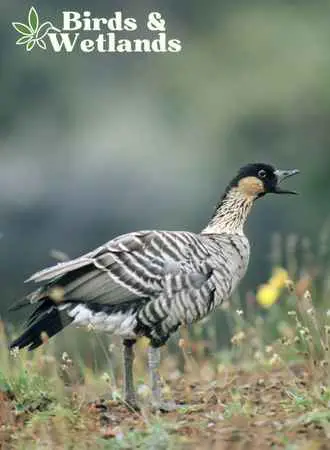
Hawaiian Goose Description
Hawaiian geese are members of the family that includes swans, true geese and whistling ducks. They are known for their brownish plumage and distinctive black-and-white markings.
Adult Hawaiian geese have dark brown upper parts and black wings and tail feathers, while their lower halves are cream-colored and pale buff-edged.
Additionally, they feature a distinctive black collar around the base of their necks, and they have long, dark legs and partially webbed feet. Their heads are also characterized by brownish-black feathers on the face, chin, crown, nape, and hindneck, as well as a patch of golden-buff feathers on their neck sides and forenecks.
Unlike other geese, which are generally much more active and migratory, the nene is sedentary and generally stays within the bounds of its native Hawaiian islands. Seasonal movements are rare and limited.
Additionally, due to its relative isolation from harsh weather patterns found in much of the world, the nene has relatively weak wings that rarely take it outside Hawaii or on long migrations elsewhere.
Another key difference between this geese species and others is its swimming habits. Unlike other geese, which typically have fully webbed feet for effective aquatic foraging and transport, the nene’s feet are only partially webbed.
However, despite this weakness in water activity, the evolution of longer legs and toes in this species allows them to negotiate more effectively over rocky ground than other birds might be able to.
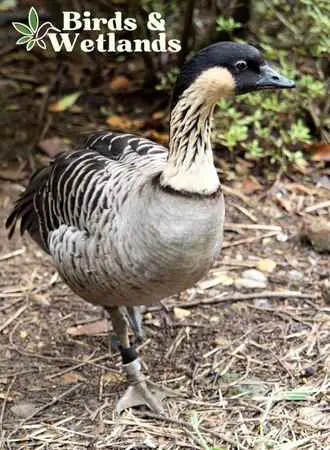
Listen to Hawaiian Goose
The Hawaiian goose, or nēnē, is known for its distinctive call. This low, soft sound is said to be similar to the word “ne ne”, and it is often used to refer to this bird species.
Hawaiian Goose Habitat & Range
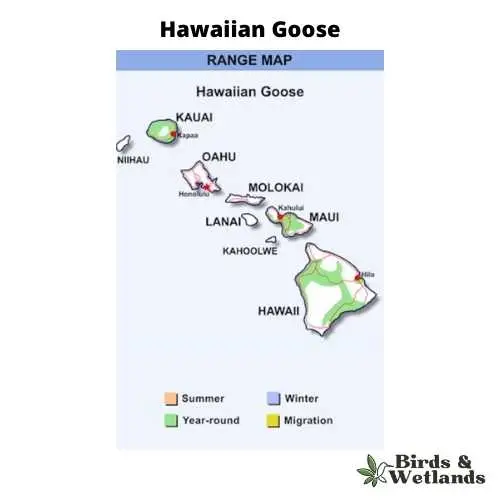
The Hawaiian goose, or nene, is well adapted to its terrestrial life and can be found in a variety of habitats, including shrubland, grassland, coastal dunes, lava fields, golf courses and upland habitats. This species frequents the lava flows on volcanic slopes with sparse vegetation, but it can also be found in grassland when available. The nene is a hardy bird that can tolerate regions without wet areas.
The Hawaiian goose is currently only found in remote areas in Hawaiʻi (Big Island), Maui, Molokaʻi, and Kauai. Most of the Hawaiian geese live in and around Hawaii Volcanoes National Park. Some tame nene are housed at the Honolulu Zoo. On the Big Island, the current distribution of Nene is primarily on the slopes of Mauna Loa, Kilauea, and Hualalai.
Hawaiian Goose Diet
The foraging behavior of the Hawaiian goose is rooted in its diet, primarily composed of various vegetation types. This bird feeds on grasses, leaves, sedges, seeds, berries, and other plants. It consumes both native and non-native vegetation in its habitat, depending on what is available at different elevations.
In addition, the Hawaiian goose also takes advantage of certain types of non-native grasses that grow at higher elevations. This bird typically forages on land almost exclusively; however, there have also been some reports of limited water-probing behaviors.
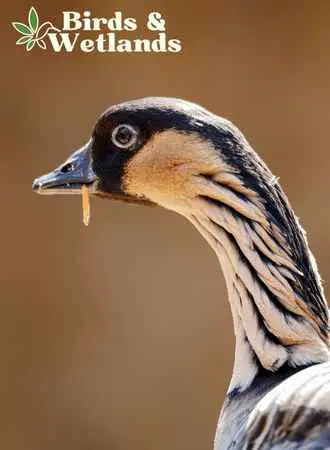
Hawaiian Goose Mating & Nesting Habits
The nesting and mating habits of the Hawaiian goose, or nene, are quite unique for a goose. Unlike most other waterfowl, the nene mates on land rather than in the water.
The breeding season for these birds extends from August to April, making it longer than any other goose species.
Nests are usually bowl-shaped in shallow scrape lined with down and soft plant materials. Their preferred nesting sites include woodlands and grasslands.
During this time, females typically lay one to five eggs in a nest built by themselves on a chosen site. After laying their eggs, the female incubates them for 29 to 32 days while the male acts as a sentry and keeps watch over her and their nest.
Once the eggs have hatched, both parents care for the goslings or young birds until they mature enough to leave the nest independently.
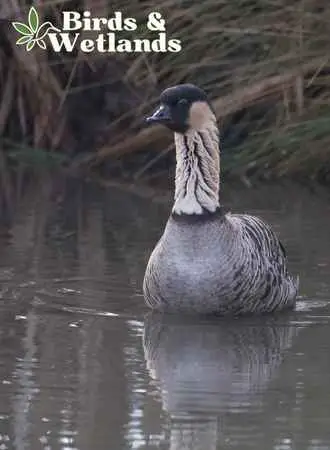
Hawaiian Goose Population & Conservation
With an estimated population of 2,500 birds, the Hawaiian goose is the world’s rarest goose species. This precarious status is largely due to centuries of predation by non-native predators such as pigs, small Indian mongooses, and feral cats. In fact, as recently as 1952, the nene population was reduced to 30 birds in the wild.
Thankfully, steps have been taken to conserve this exquisite creature. Today, conservation efforts have resulted in a population that has recovered to over 2,500 individuals. Efforts to protect the geese include predator control measures such as fencing and trapping invasive species like feral cats and mongooses.
The nene was listed as endangered under the precursor to the Endangered Species Act. Today, the IUCN categorizes the nene as Near Threatened.
Additionally, collaborative efforts among conservation groups and government agencies such as the U.S Fish and Wildlife Service are working to monitor populations and habitat conditions continually. Through these concerted efforts, we hope the Hawaiian goose will continue to thrive for generations.
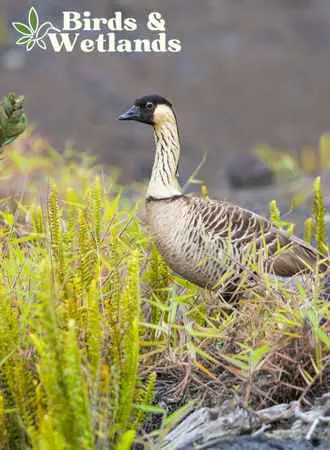
Hawaiian Goose Hunting
Waterfowl hunting, especially endangered species such as the Hawaiian geese, is strictly prohibited in Hawaii.
Key Points
The Hawaiian goose, or nene, is a medium-sized goose with a black head and less webbing on the feet endemic to the Hawaiian Islands.
This endangered species of goose descended from the gain Canada goose and was designated as Hawaii’s state bird in 1951.
Adult Hawaiian geese have dark brown upper parts and black wings and tail feathers, while their lower halves are cream-colored and pale buff-edged. They also feature a distinctive black collar around the base of their necks, long dark legs, partially webbed feet, and brownish-black feathers on their face, chin crown, nape, hindneck & neck sides.
The nene is sedentary & has relatively weak wings that rarely take it outside Hawaii or on long migrations elsewhere; however its longer legs & toes allow it to negotiate more effectively over rocky ground than other birds might be able to.
Most of the Hawaiian geese live in and around Hawaii Volcanoes National Park but some tame nene are housed at the Honolulu Zoo.
Despite conservation efforts, the nene is still a threatened species due to scarcity of food sources, climate change, habitat loss and predation by introduced mammals such as mongooses and dogs.


